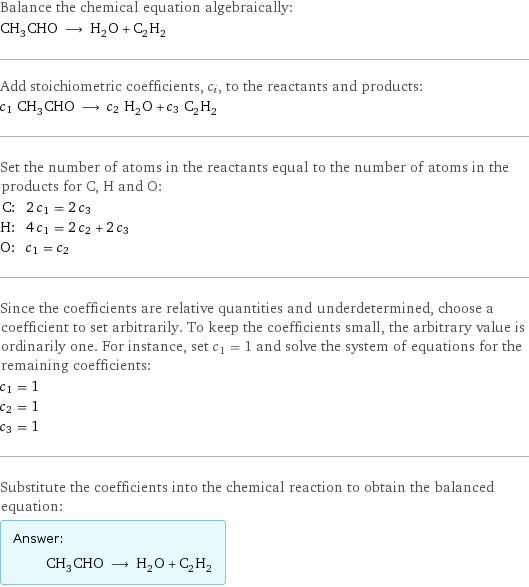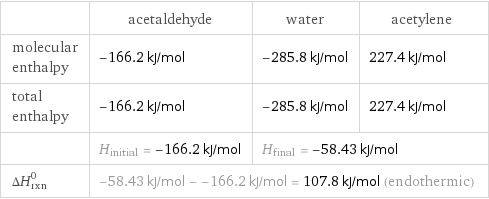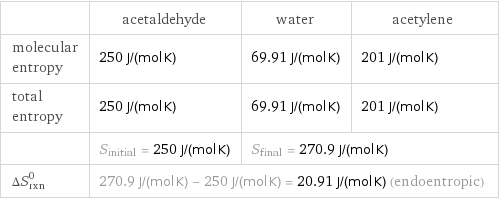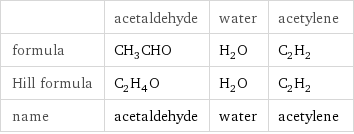Input interpretation

CH_3CHO acetaldehyde ⟶ H_2O water + C_2H_2 acetylene
Balanced equation

Balance the chemical equation algebraically: CH_3CHO ⟶ H_2O + C_2H_2 Add stoichiometric coefficients, c_i, to the reactants and products: c_1 CH_3CHO ⟶ c_2 H_2O + c_3 C_2H_2 Set the number of atoms in the reactants equal to the number of atoms in the products for C, H and O: C: | 2 c_1 = 2 c_3 H: | 4 c_1 = 2 c_2 + 2 c_3 O: | c_1 = c_2 Since the coefficients are relative quantities and underdetermined, choose a coefficient to set arbitrarily. To keep the coefficients small, the arbitrary value is ordinarily one. For instance, set c_1 = 1 and solve the system of equations for the remaining coefficients: c_1 = 1 c_2 = 1 c_3 = 1 Substitute the coefficients into the chemical reaction to obtain the balanced equation: Answer: | | CH_3CHO ⟶ H_2O + C_2H_2
Structures

⟶ +
Names

acetaldehyde ⟶ water + acetylene
Reaction thermodynamics
Enthalpy

| acetaldehyde | water | acetylene molecular enthalpy | -166.2 kJ/mol | -285.8 kJ/mol | 227.4 kJ/mol total enthalpy | -166.2 kJ/mol | -285.8 kJ/mol | 227.4 kJ/mol | H_initial = -166.2 kJ/mol | H_final = -58.43 kJ/mol | ΔH_rxn^0 | -58.43 kJ/mol - -166.2 kJ/mol = 107.8 kJ/mol (endothermic) | |
Gibbs free energy

| acetaldehyde | water | acetylene molecular free energy | -129 kJ/mol | -237.1 kJ/mol | 209.9 kJ/mol total free energy | -129 kJ/mol | -237.1 kJ/mol | 209.9 kJ/mol | G_initial = -129 kJ/mol | G_final = -27.2 kJ/mol | ΔG_rxn^0 | -27.2 kJ/mol - -129 kJ/mol = 101.8 kJ/mol (endergonic) | |
Entropy

| acetaldehyde | water | acetylene molecular entropy | 250 J/(mol K) | 69.91 J/(mol K) | 201 J/(mol K) total entropy | 250 J/(mol K) | 69.91 J/(mol K) | 201 J/(mol K) | S_initial = 250 J/(mol K) | S_final = 270.9 J/(mol K) | ΔS_rxn^0 | 270.9 J/(mol K) - 250 J/(mol K) = 20.91 J/(mol K) (endoentropic) | |
Equilibrium constant
![Construct the equilibrium constant, K, expression for: CH_3CHO ⟶ H_2O + C_2H_2 Plan: • Balance the chemical equation. • Determine the stoichiometric numbers. • Assemble the activity expression for each chemical species. • Use the activity expressions to build the equilibrium constant expression. Write the balanced chemical equation: CH_3CHO ⟶ H_2O + C_2H_2 Assign stoichiometric numbers, ν_i, using the stoichiometric coefficients, c_i, from the balanced chemical equation in the following manner: ν_i = -c_i for reactants and ν_i = c_i for products: chemical species | c_i | ν_i CH_3CHO | 1 | -1 H_2O | 1 | 1 C_2H_2 | 1 | 1 Assemble the activity expressions accounting for the state of matter and ν_i: chemical species | c_i | ν_i | activity expression CH_3CHO | 1 | -1 | ([CH3CHO])^(-1) H_2O | 1 | 1 | [H2O] C_2H_2 | 1 | 1 | [C2H2] The equilibrium constant symbol in the concentration basis is: K_c Mulitply the activity expressions to arrive at the K_c expression: Answer: | | K_c = ([CH3CHO])^(-1) [H2O] [C2H2] = ([H2O] [C2H2])/([CH3CHO])](../image_source/28a6499a7dcb8c10d0a1fe53adcb3a58.png)
Construct the equilibrium constant, K, expression for: CH_3CHO ⟶ H_2O + C_2H_2 Plan: • Balance the chemical equation. • Determine the stoichiometric numbers. • Assemble the activity expression for each chemical species. • Use the activity expressions to build the equilibrium constant expression. Write the balanced chemical equation: CH_3CHO ⟶ H_2O + C_2H_2 Assign stoichiometric numbers, ν_i, using the stoichiometric coefficients, c_i, from the balanced chemical equation in the following manner: ν_i = -c_i for reactants and ν_i = c_i for products: chemical species | c_i | ν_i CH_3CHO | 1 | -1 H_2O | 1 | 1 C_2H_2 | 1 | 1 Assemble the activity expressions accounting for the state of matter and ν_i: chemical species | c_i | ν_i | activity expression CH_3CHO | 1 | -1 | ([CH3CHO])^(-1) H_2O | 1 | 1 | [H2O] C_2H_2 | 1 | 1 | [C2H2] The equilibrium constant symbol in the concentration basis is: K_c Mulitply the activity expressions to arrive at the K_c expression: Answer: | | K_c = ([CH3CHO])^(-1) [H2O] [C2H2] = ([H2O] [C2H2])/([CH3CHO])
Rate of reaction
![Construct the rate of reaction expression for: CH_3CHO ⟶ H_2O + C_2H_2 Plan: • Balance the chemical equation. • Determine the stoichiometric numbers. • Assemble the rate term for each chemical species. • Write the rate of reaction expression. Write the balanced chemical equation: CH_3CHO ⟶ H_2O + C_2H_2 Assign stoichiometric numbers, ν_i, using the stoichiometric coefficients, c_i, from the balanced chemical equation in the following manner: ν_i = -c_i for reactants and ν_i = c_i for products: chemical species | c_i | ν_i CH_3CHO | 1 | -1 H_2O | 1 | 1 C_2H_2 | 1 | 1 The rate term for each chemical species, B_i, is 1/ν_i(Δ[B_i])/(Δt) where [B_i] is the amount concentration and t is time: chemical species | c_i | ν_i | rate term CH_3CHO | 1 | -1 | -(Δ[CH3CHO])/(Δt) H_2O | 1 | 1 | (Δ[H2O])/(Δt) C_2H_2 | 1 | 1 | (Δ[C2H2])/(Δt) (for infinitesimal rate of change, replace Δ with d) Set the rate terms equal to each other to arrive at the rate expression: Answer: | | rate = -(Δ[CH3CHO])/(Δt) = (Δ[H2O])/(Δt) = (Δ[C2H2])/(Δt) (assuming constant volume and no accumulation of intermediates or side products)](../image_source/3e2fd9c5a7e908fad5c9901b625316f5.png)
Construct the rate of reaction expression for: CH_3CHO ⟶ H_2O + C_2H_2 Plan: • Balance the chemical equation. • Determine the stoichiometric numbers. • Assemble the rate term for each chemical species. • Write the rate of reaction expression. Write the balanced chemical equation: CH_3CHO ⟶ H_2O + C_2H_2 Assign stoichiometric numbers, ν_i, using the stoichiometric coefficients, c_i, from the balanced chemical equation in the following manner: ν_i = -c_i for reactants and ν_i = c_i for products: chemical species | c_i | ν_i CH_3CHO | 1 | -1 H_2O | 1 | 1 C_2H_2 | 1 | 1 The rate term for each chemical species, B_i, is 1/ν_i(Δ[B_i])/(Δt) where [B_i] is the amount concentration and t is time: chemical species | c_i | ν_i | rate term CH_3CHO | 1 | -1 | -(Δ[CH3CHO])/(Δt) H_2O | 1 | 1 | (Δ[H2O])/(Δt) C_2H_2 | 1 | 1 | (Δ[C2H2])/(Δt) (for infinitesimal rate of change, replace Δ with d) Set the rate terms equal to each other to arrive at the rate expression: Answer: | | rate = -(Δ[CH3CHO])/(Δt) = (Δ[H2O])/(Δt) = (Δ[C2H2])/(Δt) (assuming constant volume and no accumulation of intermediates or side products)
Chemical names and formulas

| acetaldehyde | water | acetylene formula | CH_3CHO | H_2O | C_2H_2 Hill formula | C_2H_4O | H_2O | C_2H_2 name | acetaldehyde | water | acetylene
Substance properties

| acetaldehyde | water | acetylene molar mass | 44.053 g/mol | 18.015 g/mol | 26.038 g/mol phase | gas (at STP) | liquid (at STP) | gas (at STP) melting point | -123 °C | 0 °C | -81 °C boiling point | 20.1 °C | 99.9839 °C | -75 °C density | 0.784 g/cm^3 (at 20 °C) | 1 g/cm^3 | 0.618 g/cm^3 (at -55 °C) solubility in water | miscible | | surface tension | 0.0212 N/m | 0.0728 N/m | 0.01431 N/m dynamic viscosity | 2.456×10^-4 Pa s (at 15 °C) | 8.9×10^-4 Pa s (at 25 °C) | odor | | odorless |
Units
